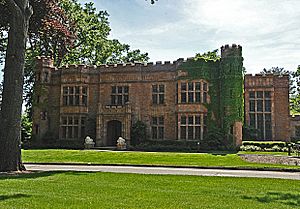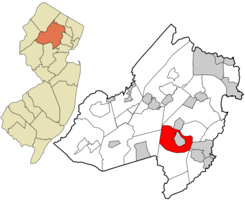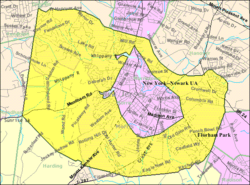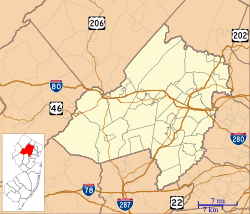Morris Township, New Jersey facts for kids
Quick facts for kids
Morris Township, New Jersey
|
||
|---|---|---|
|
Township
|
||

Alnwick Hall
|
||
|
||
| Motto(s):
A community rich in history with a constant striving for a better tomorrow.
|
||

Location of Morris Township in Morris County highlighted in red (right). Inset map: Location of Morris County in New Jersey highlighted in orange (left).
|
||

Census Bureau map of Morris Township, New Jersey
|
||
| Country | ||
| State | ||
| County | ||
| Formed | March 25, 1740 | |
| Incorporated | February 21, 1798 | |
| Named for | Lewis Morris | |
| Government | ||
| • Type | Township | |
| • Body | Township Committee | |
| Area | ||
| • Total | 15.81 sq mi (40.96 km2) | |
| • Land | 15.68 sq mi (40.62 km2) | |
| • Water | 0.13 sq mi (0.34 km2) 0.83% | |
| Area rank | 171st of 565 in state 13th of 39 in county |
|
| Elevation | 433 ft (132 m) | |
| Population
(2020)
|
||
| • Total | 22,974 | |
| • Estimate
(2023)
|
23,507 | |
| • Rank | 116th of 565 in state 5th of 39 in county |
|
| • Density | 1,465.0/sq mi (565.6/km2) | |
| • Density rank | 338th of 565 in state 19th of 39 in county |
|
| Time zone | UTC−05:00 (Eastern (EST)) | |
| • Summer (DST) | UTC−04:00 (Eastern (EDT)) | |
| ZIP Code | ||
| Area code(s) | 973 | |
| FIPS code | 3402748090 | |
| GNIS feature ID | 0882193 | |
Morris Township is a community in Morris County, in the U.S. state of New Jersey. It is called a township, which is a type of local government. In 2020, about 22,974 people lived here. This was a small increase from 2010. The township is named after Lewis Morris, who was a colonial governor of New Jersey.
Morris Township is known as a "bedroom community." This means many people live here but travel to work in bigger cities nearby. For example, many residents commute to New York City using NJ Transit trains. These trains go directly to New York Penn Station and Hoboken Terminal.
An interesting fact about Morris Township is that it completely surrounds the town of Morristown. It's like a doughnut around Morristown! For a long time, Morristown was part of Morris Township. But in 1865, Morristown started to separate, and by 1895, it became its own independent town.
Morris Township is also home to some cool places. You can find the Morris County Golf Club here. The Morris Museum is also in the township. It's the second largest museum in New Jersey and has been open since 1913. Plus, the Morristown National Historical Park is here. It became the country's first National Historical Park in 1933.
Contents
History of Morris Township
Morris Township was first created on March 25, 1740. It was named after Lewis Morris, who was the colonial governor of New Jersey.
Over the years, parts of Morris Township were used to create other towns. For example, Roxbury Township was formed in 1740. Mendham Township was formed in 1749. Morris Township officially became an incorporated township on February 21, 1798. This was part of New Jersey's first group of 104 townships.
Later, more areas were taken from the township. These included Chatham Township in 1806. Morristown separated in 1865 and became fully independent in 1895. Passaic Township, now called Long Hill Township, was formed in 1866.
Historic Places in Morris Township
Morris Township has several important historical sites. Many of these are part of the Washington Valley Historic District. This district was added to the National Register of Historic Places in 1992. Two famous spots in Washington Valley are the Washington Valley Schoolhouse and the John Smith House.
The community of Convent Station is named after its train station. This station was built in the 1870s to serve the Academy of Saint Elizabeth. This is a Catholic school that has been operating for a long time. The Morris Township Municipal Building and Police Headquarters are also located in Convent Station.
Geography and Location
Morris Township covers about 15.81 square miles (40.96 square kilometers). Most of this area is land, with a small amount of water.
Several smaller communities and places are located within the township. These include Convent Station, Gillespie Hill, and Washington Valley.
As mentioned, Morris Township completely surrounds Morristown. This is a unique situation where one town is entirely inside another. Morris Township also shares borders with several other towns in Morris County. These include Denville, Parsippany–Troy Hills Township, Morris Plains, and Hanover Township to the north. To the south is Harding Township. To the west are Mendham Township and Randolph. To the east are Florham Park and Madison.
Population and People
| Historical population | |||
|---|---|---|---|
| Census | Pop. | %± | |
| 1810 | 3,753 | * | — |
| 1820 | 3,524 | −6.1% | |
| 1830 | 3,536 | 0.3% | |
| 1840 | 4,013 | 13.5% | |
| 1850 | 4,992 | 24.4% | |
| 1860 | 5,985 | 19.9% | |
| 1870 | 5,674 | −5.2% | |
| 1880 | 1,419 | * | −75.0% |
| 1890 | 1,999 | 40.9% | |
| 1900 | 2,571 | 28.6% | |
| 1910 | 3,161 | 22.9% | |
| 1920 | 2,824 | * | −10.7% |
| 1930 | 5,565 | 97.1% | |
| 1940 | 6,107 | 9.7% | |
| 1950 | 7,432 | 21.7% | |
| 1960 | 12,092 | 62.7% | |
| 1970 | 19,414 | 60.6% | |
| 1980 | 18,486 | −4.8% | |
| 1990 | 19,952 | 7.9% | |
| 2000 | 21,796 | 9.2% | |
| 2010 | 22,306 | 2.3% | |
| 2020 | 22,974 | 3.0% | |
| 2023 (est.) | 23,507 | 5.4% | |
| Population sources: 1810–1920 1840 1850–1870 1850 1870 1880–1890 1890–1910 1910–1930 1940–2000 2000 2010 2020 * = Lost territory in previous decade. |
|||
In 2020, the 2020 United States census counted 22,974 people living in Morris Township. There were 8,172 households. Most residents, about 76.8%, were white. About 4.6% were Black or African-American, and 6.0% were Asian. About 8.0% of the population identified as Hispanic or Latino.
The average household in Morris Township had about 2.6 people. The average family had about 3.0 people. About 19.0% of the population was under 18 years old. The median age in the township was 46.4 years.
Morris Township is known for being one of New Jersey's wealthier communities. This means that the average income for families and individuals is quite high compared to other places in the state.
Culture and Fun Things to Do
Morris Township offers several places for culture and recreation.
Morris Museum
The Morris Museum has been open since 1913. It is the second largest museum in New Jersey, covering a huge area of 75,524 square feet. The museum is officially recognized by the American Alliance of Museums.
Morris County Golf Club
The Morris County Golf Club was started in 1894. It was special because it was created and run by women, including Nina Howland. In 1896, the club hosted the United States Women's Amateur Golf Championship. This was the first national golf title held in New Jersey. The current golf course was designed in 1916.
Fosterfields Living Historical Farm
Since 1972, Fosterfields Living Historical Farm has been a protected historical park. It covers over 200 acres in Morris Township. Here, you can see a 1915 farmhouse and an 1854 mansion. These belonged to the family of Caroline Rose Foster. The farm offers educational programs, historical reenactments, and public concerts throughout the year. It's a great place to learn about life in the past.
Local Economy
Morris Township is home to several important organizations and businesses.
One well-known organization is The Seeing Eye. This is a famous school that trains guide dogs to help people who are blind.
Schools and Education
Students in Morris Township attend schools in the Morris School District. This district also serves students from Morristown and high school students from Morris Plains. The district has 10 schools and serves over 5,200 students.
Some of the schools in the district include:
- Lafayette Learning Center (Pre-K)
- Alexander Hamilton School (Grades 3-5)
- Hillcrest School (Grades K-2)
- Thomas Jefferson School (Grades 3-5)
- Normandy Park School (Grades K-5)
- Sussex Avenue School (Grades 3-5)
- Alfred Vail School (Grades K-2)
- Woodland School (Grades K-2)
- Frelinghuysen Middle School (Grades 6-8)
- Morristown High School (Grades 9-12)
Morris Township also has private schools. The Academy of St. Elizabeth is a Catholic school for girls. It opened in 1860 and is the oldest girls' school in New Jersey. Saint Elizabeth University is a private Catholic college for women. It was founded in 1899. The Rabbinical College of America, a large Jewish school, is also located nearby in Morristown.
Getting Around Morris Township
Morris Township has a good network of roads and public transportation options.
Roads and Highways
Several major roads pass through the township. These include Route 124, Route 24, CR 510, U.S. Route 202, and Interstate 287. These roads help people travel easily within and outside the township.
Public Transportation
The Convent Station is a NJ Transit train station. You can catch trains here on the Morristown Line. These trains go to places like Newark Broad Street Station, Secaucus Junction, Penn Station New York, and Hoboken Terminal.
NJ Transit also offers local bus services within the township. These buses help residents get around to different areas. In the past, there were even trolley services in Morris Township, but these were replaced by buses in 1928.
Notable People from Morris Township
Many interesting people have lived in or are connected to Morris Township. Here are a few:
- Ben Bailey (born 1970), a comedian and the host of the TV show Cash Cab.
- Caroline Rose Foster (1877–1979), a farmer who founded Fosterfields Living Historical Farm.
- Connor Lade (born 1989), a professional soccer player.
- Dan Quinn (born 1970), a football coach.
- Joseph Warren Revere (1812–1880), a general during the American Civil War and the grandson of Paul Revere.
Images for kids
See also
 In Spanish: Municipio de Morris (Nueva Jersey) para niños
In Spanish: Municipio de Morris (Nueva Jersey) para niños
















